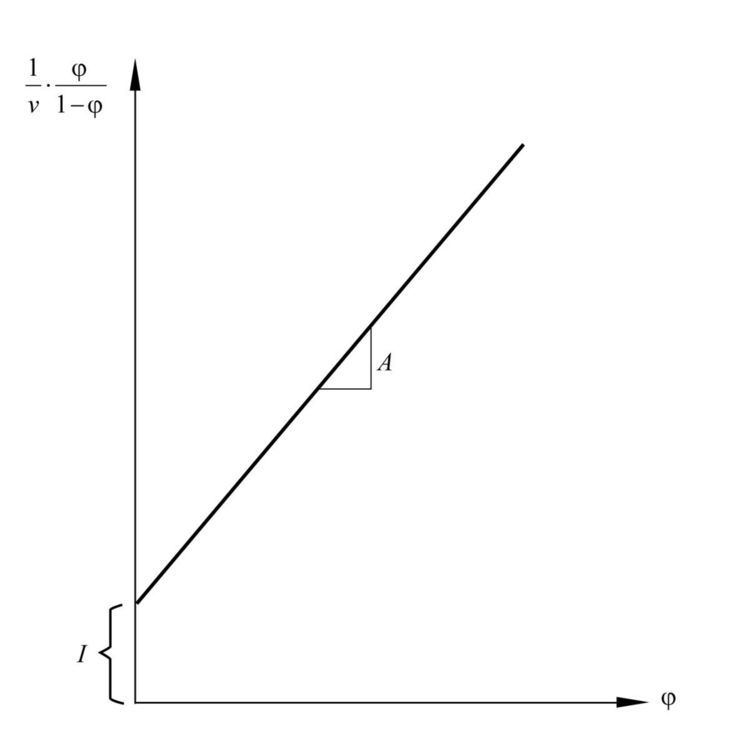 | ||
Brunauer–Emmett–Teller (BET) theory aims to explain the physical adsorption of gas molecules on a solid surface and serves as the basis for an important analysis technique for the measurement of the specific surface area of materials. In 1938, Stephen Brunauer, Paul Hugh Emmett, and Edward Teller published the first article about the BET theory in the Journal of the American Chemical Society. The BET theory applies to systems of multi layer adsorption, and usually utilizes probing gases that do not chemically react with material surfaces as adsorbates to quantify specific surface area. Nitrogen is the most commonly employed gaseous adsorbate used for surface probing by BET methods. For this reason, standard BET analysis is most often conducted at the boiling temperature of N2 (77 K). Further probing adsorbates are also utilized, albeit with lower frequency, allowing the measurement of surface area at different temperatures and measurement scales. These have included argon, carbon dioxide, and water. Specific surface area is a scale-dependent property, with no single true value of specific surface area definable, and thus quantities of specific surface area determined through BET theory may depend on the adsorbate molecule utilized and its adsorption cross section.
Contents
Concept
The concept of the theory is an extension of the Langmuir theory, which is a theory for monolayer molecular adsorption, to multilayer adsorption with the following hypotheses:
- gas molecules physically adsorb on a solid in layers infinitely;
- there is no interaction between each adsorption layer; and
- the Langmuir theory can be applied to each layer.
The resulting BET equation is
where
where
Equation (1) is an adsorption isotherm and can be plotted as a straight line with
The BET method is widely used in surface science for the calculation of surface areas of solids by physical adsorption of gas molecules. The total surface area
where
Derivation
The BET theory can be derived similarly to the Langmuir theory, but by considering multilayered gas molecule adsorption, where it is not required for a layer to be completed before an upper layer formation starts. Furthermore, the authors made five assumptions:
- Adsorptions occur only on well-defined sites of the sample surface (one per molecule)
- The only molecular interaction considered is the following one: a molecule can act as a single adsorption site for a molecule of the upper layer.
- The uppermost molecule layer is in equilibrium with the gas phase, i.e. similar molecule adsorption and desorption rates.
- The desorption is a kinetically-limited process, i.e. a heat of adsorption must be provided:
- these phenomenon are homogeneous, i.e. same heat of adsorption for a given molecule layer.
- it is E1 for the first layer, i.e. the heat of adsorption at the solid sample surface
- the other layers are assumed similar and can be represented as condensed species, i.e. liquid state. Hence, the heat of adsorption is EL is equal to the heat of liquefaction.
- At the saturation pressure, the molecule layer number tends to infinity (i.e. equivalent to the sample being surrounded by a liquid phase)
Let us consider a given amount of solid sample in a controlled atmosphere. Let θi be the fractional coverage of the sample surface covered by a number i of successive molecule layers. Let us assume that the adsorption rate Rads,i-1 for molecules on a layer (i-1) (i.e. formation of a layer i) is proportional to both its fractional surface θi-1 and to the pressure P, and that the desorption rate Rdes,i on a layer i is also proportional to its fractional surface θi:
where ki and k−i are the kinetic constants (depending on the temperature) for the adsorption on the layer (i−1) and desorption on layer i, respectively. For the adsorptions, these constant are assumed similar whatever the surface. Assuming an Arrhenius law for desorption, the related constants can be expressed as
where Ei is the heat of adsorption, equal to E1 at the sample surface and to EL otherwise.
Cement paste
By application of the BET theory it is possible to determine the inner surface of hardened cement paste. If the quantity of adsorbed water vapor is measured at different levels of relative humidity a BET plot is obtained. From the slope
From this the specific BET surface area
Activated Carbon
For example, activated carbon strongly adsorbs many gases and has an adsorption cross section
Catalysis
In the field of solid catalysis, the surface area of catalysts is an important factor in catalytic activity. Porous inorganic materials such as mesoporous silica and layered clay minerals have high surface areas of several hundred m² g−1 calculated by the BET method, indicating the possibility of application for efficient catalytic materials.
Specific surface area calculation
The ISO 9277 standard for calculating the specific surface area of solids is based on the BET method.
